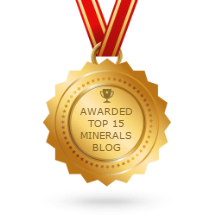The first week of January rarely provides much professional news, but there was good news from Scotland on the first of the month, when we heard that my old friend and former Camborne School of Mines colleague, Prof. Richard Williams, was awarded the CBE in the New Year's Honours list. Commander of the Order of the British Empire is an award given to people who have made a significant contribution to the country and to their area of activity. The CBE is the highest ranking Order of the British Empire excluding a knighthood or damehood and is one level up on the OBE (Officer of the Order of the British Empire) an award which Richard has also held since 2009.
Richard is Principal and Vice Chancellor at Heriot-Watt University, UK and I first met him in 1986 in Falmouth at the NATO Advanced Study Institute Mineral Processing at a Crossroads. Richard was then a research associate at Imperial College, just after being awarded his PhD. I have followed his meteoric career progression since then and we were pleased to see him at Critical Minerals '24 in Cape Town last November, where he delivered an excellent presentation. Many congratulations, Richard, on a well deserved award honouring an outstanding career.
 |
| Richard with Barbara and me at Critical Minerals '24 dinner at Groot Constantia wine estate |
The professional world awakened again in the second week of the month, after its festive slumber, but it was a week of natural disasters and chaos. Much of the UK was covered in snow, and heavy rains caused severe flooding, leading to more than usual travel chaos on road and rail. But this was nothing compared to the earthquake in Tibet, which led to major loss of life, and the apocalyptic wildfires in California, which devastated the Los Angeles area with major loss of property and lives.
West Cornwall tends to miss such extremes and our thoughts were mainly on the next MEI conference, Comminution '25, with its record number of papers, and a major exhibition, with all 30 booths sold by the end of the first week of the month. We are pleased that Glencore Technology and CEEC are running workshops on the afternoon before the conference welcoming reception. Two regulars who will be sorely missed are Sam Palaniandy, who died last May (posting of 6th May 2024) and John Starkey, who died earlier this month (posting of 15th January 2025). John's memorial service is in Oakville, Ontario today.
All efforts are being made to ensure the success of Comminution '25, and of Flotation '25 in November, and it is a bonus that, due to the internet, we can live and work anywhere in the world. In the middle of the month Amanda took herself off to Thailand for a 10 day working holiday, keeping in touch daily with me in Cornwall and Jon in Luxembourg, while enjoying the warmth.
On the 20th of the month Donald Trump was once more unleashed on the world, beginning his term as 47th US President by pledging a boost in fossil fuel production, vowing to withdraw the US from the Paris climate agreement, the world's most important effort to tackle rising temperatures. The US will now join Iran, Yemen and Libya as the only countries to currently stand outside the agreement, which was signed 10 years ago in the French capital. Trump's ignorance of the agreement was echoed in his statement in 2017 that he had been elected to represent the people of Pittsburgh and "not Paris". The following months should be interesting!
















































%20(1).png)












-EDIT.jpg)


